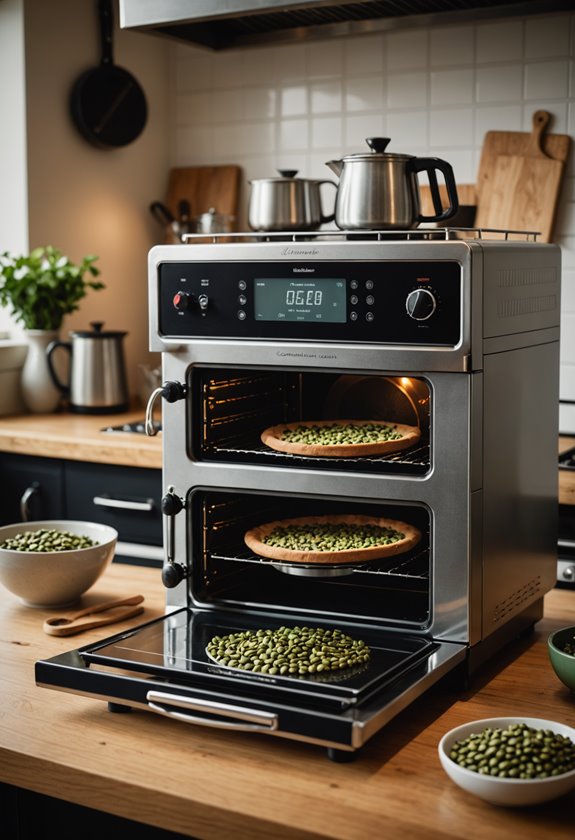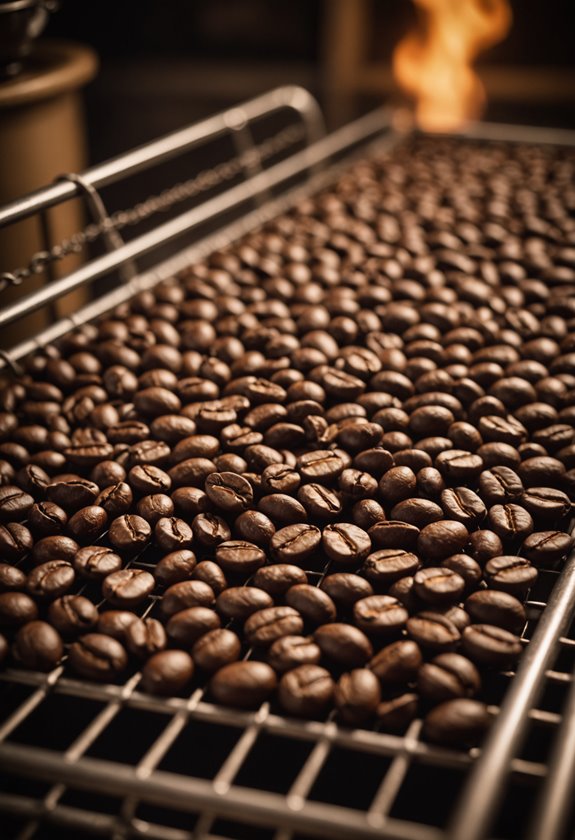How to Roast Coffee Beans in a Convection Oven?
To roast coffee beans in a convection oven, start by preheating your oven to 450°F, ensuring even roasting conditions. Use a perforated baking tray to promote airflow around the beans. Spread green beans in a single layer, allowing a central gap for extra airflow. Stir the beans every few minutes, listening closely for the first crack at 6-8 minutes, marking the start of the roasting phase. Aim for your preferred roast level: the second crack at 10-15 minutes indicates a medium roast. Cool beans quickly to halt roasting. Let's investigate how different roast levels can craft unique flavors.
Key Takeaways
- Preheat the convection oven to 450°F for optimal roasting conditions.
- Spread green beans in a single layer on a perforated baking tray.
- Stir beans every few minutes to ensure even roasting.
- Listen for the first crack at 6-8 minutes to monitor roast progress.
- Quickly cool beans in a heat-resistant bowl to halt the roasting process.
Preparing Your Equipment

Before you start roasting coffee beans, it's important to prepare your equipment properly. First, make sure your convection oven is preheated to around 450°F. This step is significant for creating an ideal roasting environment.
Use a perforated baking tray or cookie sheet to promote airflow around the beans. This helps achieve even roasting, as it allows heat to circulate freely.
Next, gather a stirring tool, like a wooden spoon, for agitation during the roasting process. Agitation guarantees that all beans are roasted evenly. You'll also need a heat-resistant bowl ready for cooling the beans once they're roasted.
Monitoring the internal temperature with an oven thermometer is crucial since convection ovens can vary in actual temperature compared to the set temperature.
Set a timer to keep track of the roasting process. You'll want to listen for the first crack, which generally occurs around 6-8 minutes, and the second crack, which follows between 10-15 minutes. These audible cues are important in determining different roast levels.
Roasting Process Steps
Once your equipment is prepared, you're ready to plunge into the roasting process. Preheat your convection oven to 450°F, as this guarantees ideal heat distribution.
Spread a single layer of green coffee beans on a cookie sheet, making certain to create a central hole. This allows hot air to circulate, promoting an even roast.
Let's investigate the essential steps in the roasting process:
- Monitor the beans closely: Keep a watchful eye on them, stirring every few minutes to achieve a consistent color and prevent burning.
- Listen for the first crack: This usually occurs between 6-8 minutes, marking the beginning of the roasting phase.
- Reach your desired roast level: The second crack, around 10-15 minutes, signals a medium roast. Adjust time to your preference.
- Cool the beans quickly: Use a heat-resistant bowl or colander to stop the roasting process promptly and enhance flavor.
After roasting, store your freshly roasted beans in airtight containers away from light and moisture to preserve their rich flavors.
Achieving Desired Flavors

As you monitor the roasting process, attaining your desired flavors becomes the next critical step. Start by closely observing the roast time, aiming between 12-15 minutes to develop ideal taste without over-roasting. Over-roasting can dull the flavors of your coffee beans.
Pay attention to the first crack, which typically occurs between 6-8 minutes, marking the shift to a light roast. The second crack signals a medium roast, allowing you to adjust flavors to your liking.
Temperature and Air Flow****
Maintaining a consistent temperature of around 450°F is vital. This guarantees even roasting, preventing the beans from becoming burnt or unevenly roasted, which can negatively impact flavor.
A convection oven helps with this by providing better air flow, aiding in a more uniform roast. This preserves the unique flavor characteristics of beans from various origins, offering you a chance to investigate different taste profiles.
Experiment with Roast Levels
Experimenting with different roast levels—light, medium, and dark—offers distinct flavor profiles. Light roasts highlight acidity and floral notes, while dark roasts emphasize bittersweet qualities.







